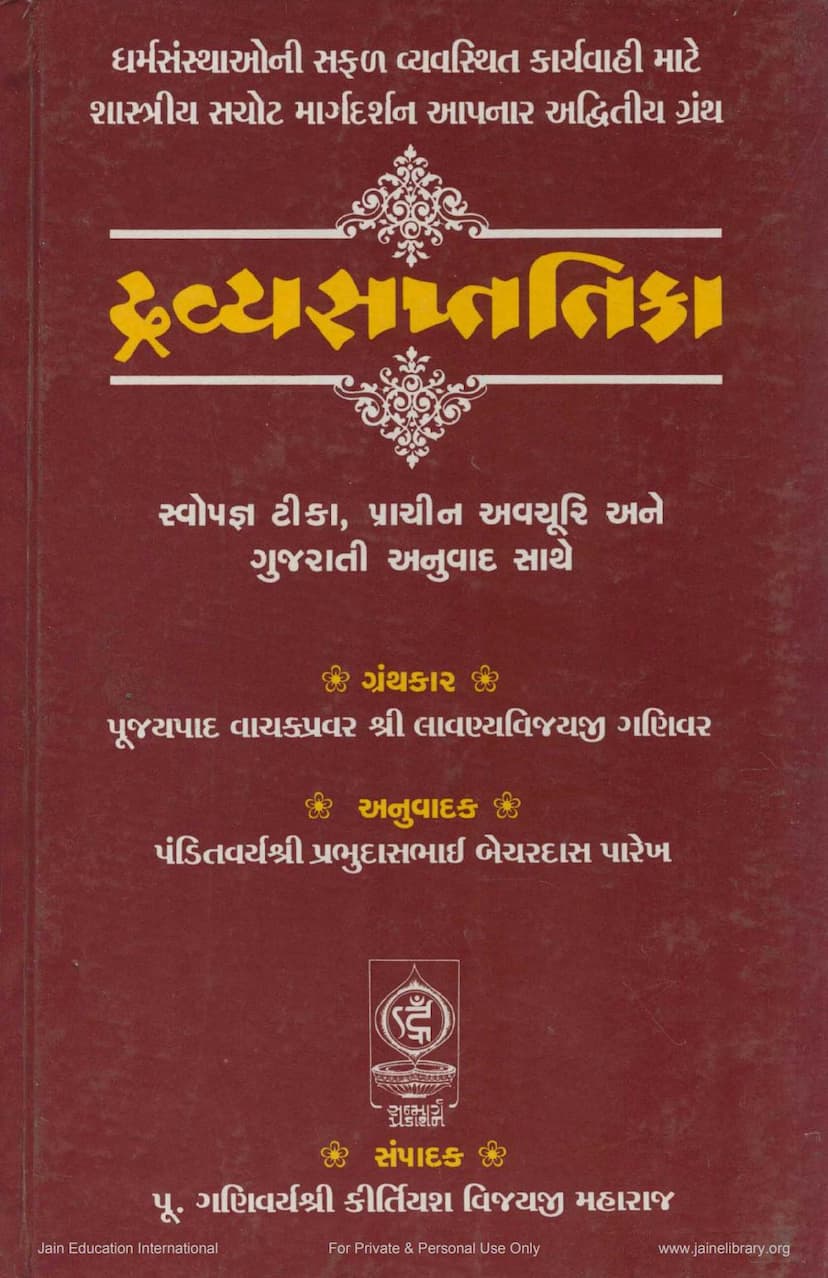Dravya Saptatika
Added to library: September 1, 2025

Summary
This document is the introduction and table of contents for the Jain text Dravya Saptatika (દ્રવ્યસપ્તતિકા). It appears to be a scholarly edition published by Sanmarg Prakashan, and it includes the original text, its commentary (swopajnya tika), an ancient commentary (prachina avchuri), and a Gujarati translation.
Here's a breakdown of the key information and themes presented in these pages:
1. Title and Authorship:
- Book Title: Dravya Saptatika (દ્રવ્યસપ્તતિકા)
- Author: Lavanyasuri (લાવણ્યવિજયજી ગણિવર)
- Publisher: Sanmarg Prakashan (સન્માર્ગ પ્રકાશન)
- Commentary (Tika): Swopajnya Tika (સ્વોપજ્ઞ ટીકા) by Lavanyasuri himself.
- Ancient Commentary (Avchuri): An unnamed ancient commentator.
- Gujarati Translator: Panditvarvarya Shri Prabhudasbhai Bechardas Parekh (પંડિતવર્યશ્રી પ્રભુદાસભાઈ બેચરદાસ પારેખ)
- Editor (Second Edition): Poojya Ganivaryashri Kirtiyash Vijayji Maharaj (પૂ. ગણિવર્યશ્રી કીર્તિયશ વિજયજી મહારાજ)
2. Purpose and Significance:
- The text is described as an "unequalled and unique treatise" providing "classical and accurate guidance for the successful and systematic management of religious institutions." (ધર્મસંસ્થાઓની સફળ વ્યવસ્થિત કાર્યવાહી માટે શાસ્ત્રીય સચોટ માર્ગદર્શન આપનાર અદ્વિતીય ગ્રંથ).
- It emphasizes the importance of adhering to scriptural principles in all matters of religious administration, echoing the saying "Sadhavah Shastrachakshuh" (साधव: शास्त्रचक्षुः - Saints see through the eyes of scriptures).
- The book aims to guide administrators, workers of religious institutions (Shri Sangh), and guiding spiritual leaders on matters related to Dharmadravya (religious wealth/assets) and religious administration.
3. Editions and Content:
- The publication is the first edition of the translation and editing.
- It is presented with its own commentary (Swopajnya Tika), an ancient commentary (Prachina Avchuri), and a Gujarati translation.
- The second edition was edited by Poojya Ganivaryashri Kirtiyash Vijayji Maharaj.
4. Publisher and Distribution:
- Publisher: Sanmarg Prakashan, Ahmedabad, India.
- Value: Rs. 100.00 (as per the first edition mentioned).
- Contact Information: Addresses and contact details for obtaining the book are listed, indicating distribution centers in Ahmedabad and Mumbai, as well as other cities.
5. Thematic Focus:
- The introduction and editorial notes highlight the importance of managing Dharmadravya (religious assets) according to Jain scriptural guidelines.
- It specifically mentions the management of "Satkhetara" (Seven Fields), Jivdaya (compassion for living beings), and Anukampa (sympathy), all related to religious wealth.
- The text is considered essential for those involved in the administration of religious trusts and institutions.
6. Editorial Notes on Second Edition (Page 6):
- The second edition aims to improve the presentation by placing the Gujarati translation opposite the Sanskrit original.
- It addresses issues in the first edition, such as the scattered placement of commentaries and the lack of proper numbering for textual variants and notes, which caused confusion.
- All efforts were made to maintain the original translation by Pt. Prabhudasbhai Bechardas Parekh, with improvements in layout and referencing for clarity.
7. Content of the Book (as per the Table of Contents): The detailed table of contents reveals the extensive coverage of the text, which is structured into several "Doors" (Dwar) and "Chapters" (Gatha):
- Mangalacharan (Invocation): Beginning with auspicious verses.
- Devadi-dravya-vyakhya (Explanation of Deities' and other Assets): Defining what constitutes religious assets.
- Seven Doors (Saptadwara):
- Bhed-dwar (Classification Door): Categorizing assets into five types (Chaitra-dravya, Guru-dravya, Gyan-dravya, Sadharan-dravya, Dharma-dravya) and then further classifying them.
- Vruddhi-dwar (Growth Door): Discussing how religious assets can grow, the principles of management, the authorities responsible, and the methods for growth and prevention of loss.
- Vinash-dwar (Destruction Door): Detailing various types of loss and destruction of assets, including the consequences of misappropriation and negligence. This section seems to be quite extensive, listing numerous types of destruction.
- Gun-dwar (Merit Door): Explaining the merits of proper management, leading to worldly and spiritual benefits, including examples like Sagar Shresthi.
- Dosh-dwar (Fault/Sin Door): Discussing the faults and sins associated with the misuse or mismanagement of religious assets and their dire consequences, with examples like Rudradatta.
- Prayshchitta-dwar (Atonement Door): Outlining the procedures for atonement and penance for mistakes made in managing religious assets.
- Drishtanta-dwar (Example Door): Providing various illustrative stories and examples (like Sanksash Shravak, Mahakal) to emphasize the principles.
- Appendices (Parishishta): Likely containing supplementary information, lists of texts, or further explanations.
8. Underlying Concerns (from Editorial Notes): The editorial notes touch upon the challenges faced in modern times regarding the management of religious properties, including:
- Interference from secular laws (Public Trust Act) and government bodies.
- The misuse of religious funds for non-religious purposes.
- The erosion of scriptural adherence in practical administration.
In essence, Dravya Saptatika is a foundational Jain text offering a comprehensive, scripturally-backed guide for the meticulous and ethical management of all forms of religious wealth, ensuring its preservation, growth, and proper utilization for the welfare and spiritual progress of the community, while strictly adhering to the principles laid down by the omniscient Tirthankaras.